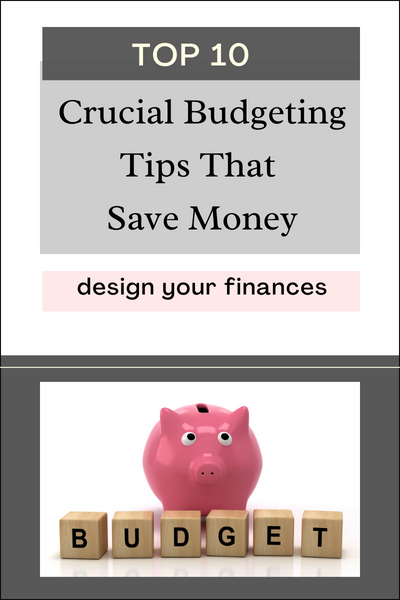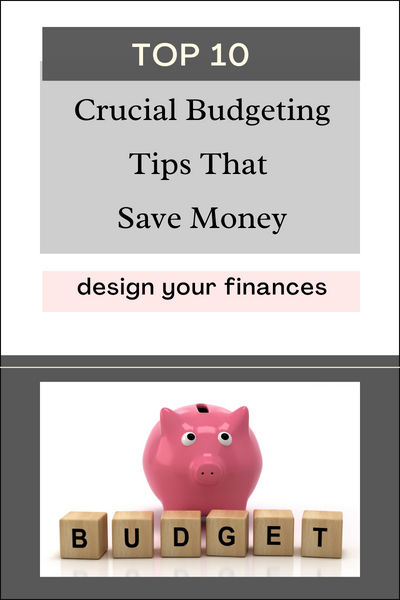-
10 Personal Budgets That Save Money Fast
 Personal budgets includes the process of managing finances by allocating, forecasting expenses and saving money.
Personal budgets includes the process of managing finances by allocating, forecasting expenses and saving money. Managing personal finances is a task that is both essential and, at times, challenging. Crafting an effective personal budget is the cornerstone of financial stability and a key to achieving your financial goals.
Designing your finances requires one to be financially savvy and that requires various aspects such as research, budgeting, investing and truthfully, discipline. The form and process of budgeting have many components and thus making it challenging to maintain a successful working budget.
Below are some different types of budgeting methods, tips, and strategies that can be easily implemented. However, a budget is not just about tracking expenses; it’s a powerful tool for saving money quickly. In this comprehensive guide, we will explore the strategies and tactics that can help you create a personal budget that not only keeps your spending in check but also accelerates your savings. From setting clear financial objectives and tracking your expenses to prioritizing savings and making frugal choices, these tips will equip you with the knowledge and skills to build a budget that can swiftly bolster your financial health. Whether you’re looking to build an emergency fund, pay off debt, or work towards a specific financial goal, a well-structured personal budget is the key to achieving those objectives with speed and efficiency. So, let’s dive into the world of personal budgets that save money fast and pave the way for a more financially secure future.
.
1. Actions Items
In order to successfully implement a budget, there are action items that one must conduct before choosing a budget that works for you.
Setting Budget Goals
You have to identify why you need to have a budget and state your objectives. Is the budget targeted for a long-term goal or short term, what purpose is it going to serve, are you paying the debt off, saving for a house and or boosting your saving or investments?
Know Your True Income
This is one of the questions many people have a hard time answering. How much is your gross and net income? This should be a starting point, as it clearly provides you with the disposable income you have. Additionally, this gives you a clearer picture of what your deductions are, knowing this information, will help immensely as you are able to adjust how much you are being taxed, which can ultimately increase your take home. The objective is to not overpay in taxes, therefore, it is best to consult a tax accountant and find ways that can decrease your taxes. NB: Tax evasion and implementing methodologies that reduce your taxes are NOT the same thing. Do not break the law, that is why a tax accountant will be instrumental in assisting you in finding LEGAL SOLUTIONS.
How Much Your Debt Is
This activity can be very stressful, especially when you have to itemize all your debt which can create a sense of being overwhelmed. Whether you itemize your debt by the lowest to highest interest rate, amount and or the number of payments, it is imperative to list all your debt and have an accurate amount of what you owe. This provides such a great blueprint, especially when you start paying off your debt, your action plan is halfway in motion.
Set Timeframes
For any goal to be successful, there have to be set realistic timeframes. Setting extremely demanding goals in a short amount of time is clearly the best way to sabotage your efforts, leading to being overwhelmed and failure. Know the exact amount of money you can allocate towards your debt each month. For a goal to be successful, it is best to follow a methodology that you can easily implement, such as S.M.A.R.T Goals
Specific identify your goal, for instance, payoff credit cards, then the student loans Measurable be able to track your progress and set your milestones. Attainable do not overstate your ability, as this may lead to disappointments. Set goals that you can achieve, such as payoff 1 credit card at a time. Realistic sometimes achieve your goal, you may need to think outside the box, such as getting another job or starting a side hustle, all these contribute to creating realistic goals Timely set dates, deadlines or milestones that allow you to succeed. .
2. Time Budgets and Personal Budgets
This type of budget is based on a specific timeframe such as a week, month or year and the goals vary from each time period to the other. Below are some examples,
Weekly Budget
This can be associated with weekly allowances which may include transactions that more frequent than the others such as, gas, groceries or getting your nails done. Having a weekly budget allows you to have some spending money and most importantly use only what is allocated.
Monthly Budget
Creating this budget focuses on transactions that are paid monthly. The budget normally includes expenses such as car note, mortgage, utilities. These expenses tend to be fixed and are on a set due date. This makes it much easier to create a budget because they hardly have any new surprises in the way they are formatted.
Yearly Budgets
Yearly budgets are expenses that are paid once a year and or quarterly and need advance budget planning and enough money allocated to achieve the goal. For instance, property taxes can fit into this category. Though some states pay property taxes more than once a year, it is surely a bill that you have to plan for. This bill is based on the value of your home, therefore, in some cases, it can increase over time. When you fail to adequately budget for this expense among others, this can surely, have a true financial burden which can lead to a tax lien.
Long Term (over a year)
Long term budgets are expenses that need more than a year of planning, funds allocation and or investing. Some of these expenses may be grouped either short or long term. When you define your expenses, it is best to accurately state your abilities. For instance, short term (though it may be longer than a year) can include expenses, such as saving for a down payment for a house or a wedding. Usually, some experts define short term objectives as five years or less.
Long term budgets are expenses that need funds allocation of least 5 years and more. These expenses include retirement and or saving for college. These expenses are well funded and increase in value if contributed consistently and for a long time. Every dollar counts, especially when setting up goals.
Due to the different types of time budgets, it is imperative that your planning and allocation process truly caters to all needs. The above-listed expenses in each category, are true expenses in any household and have to be carefully planned for. Regardless of your income level, we all have expenses that require true allocation management.
.
3. Cash Only
What is a Cash Budget, how does it help with budgeting, how do you plan it? These are the questions that need to be answered before applying this method.
What is a Cash Budget – this is a process where you only use cash for all your daily needs and if you run out of money, you DO NOT reallocate additional funds. A debit card can be used for this method, but this can really set you off if your debit card is attached to your savings or another account that has money in it.
How does it help with budgeting – the idea in any budgeting process is to stop excess spending and or incorrectly using your money. You already work so hard for your money, have multiple deductions, it only helps if your money works harder than you do. The most imperative aspect of this type of budgeting is to discipline spending habits by creating intended spending.
How Do You Plan for it – the best approach is to start small and then gradually increase your budgeting process. The first step is to identify expenses and or categories that you can easily pay with cash, such as groceries, lunch, transportation. Thereafter, you need to set a time-based approach such as, when you can withdraw your cash and how long the money should last. Tracking your progress is vitally important, therefore, constantly tallying your expenses is a big help.
TIP- use your debit cards, only if you are able to keep to your goal, as it may become hard to manage.
Related articles:
- Tools For an Income Blog
- Effective Personal Budgets
- 10 Effective Personal Budget Tips
- 10 Investments that Create Wealth
- How to Organize Your Blogging Business
- How to Save for Money for Big Events in Life
- How I Got a Six-Figure Raise 80k to over 150k
.
4. The Envelope System
This method has the same setup as the cash budget but it is more detailed and can include a wide range of categories. All or most of your bills are paid through the envelope system.
How Do You Plan for it – the first step is to organize your expenses into categories, then allocating the funds to that category. For instance, your categories can include but not limited to, groceries, utilities, transportation and or clothing. Next step, is to aggregate the amount of each category that is going to last you till the next cash distribution in that category, for instance, you allocate funds into your envelopes every 15th of each month – that means no topping funds until the next due date, the 15th of next month.
How to Succeed – by tracking your expenses and carefully allocating the correct amount. Usually, budget shortages occur when there is a mismanagement. You may need to reallocate more funds in one category than the norm because it might be a necessity. For instance, utilities usually go up in summer months and that is reflected in your bills. You may try to eliminate some expenses and or reducing other categories such as clothing.
.
5. Bare Budget
This type of budget is only for bare necessities. It does not include any additional expenses such as luxuries, fun or social. As the theme continues, the first step is to always list your exact expenses.
When to Use it – bare budgeting is an extreme form of “money discipline” it does not allow any room other than what is required to survive. Usually, this form of budgeting is used when there is an aggressive goal and or limited timeframe, such as paying the debt off or saving for a down payment. Since it is extreme, it can be hard to maintain it in the long term.
Two forms of Bare Budget – personal finance is all about understanding and tracking where your money is being allocated. This is more enhanced with the Bare Budget, mainly because there are two forms, emergency budgeting or cutting back budgeting. Emergency budgeting is trimming your budget to only survival necessities such as food, shelter. Cutting Back Budgeting is when you still cut down expenses but also have room to allow some of “luxuries” such as entertainment, maybe one vacation per year. Of course, with cutting back budgeting, it should be planned in advance.
.
6. The Debt Free Budget
The above-listed requirements for the other budgets are the same for this one, listing your expenses first. The Debt-Free Budget supports the theory of saving first and not getting to debt.
How it Works – the success of this type of budget is to save first the required amount and then purchase what you need. If you cannot buy it with cash, you cannot afford it. This type of budgeting works well with gifts, vacations. At the beginning of the year, you can fund your budget in small increments, this really helps as the contributions are much smaller compared to last-minute payments.
How to Succeed – the main purpose of this budget is NOT TO GET INTO DEBT. Usually, the justification of expenses is a major driving force of getting into debt. For instance, if buying gifts or vacation, calculate the total cost, then divide into manageable installments.
.
7. Percentage Based Budget
This budget is framed and calculated from a percentage-based basis. You allocate a certain percentage for each main category, the idea behind it is that you cannot go above your set percentage. For instance:
Fifty percent – of your take-home goes toward needs and necessities such as shelter, food, utilities, debt repayment. It is better to have most of the allocation towards debt repayment and the reminder on other categories.
Thirty percent – of your take-home is spent on wants, such as clothing, eating out, hobbies. The idea behind this type of budget is to also enjoy life and not be so strict with money. Unfortunately, most have fallen short when it comes to this portion because needs and wants are ever-growing and usually accompanied by a rationale to go above the allocated percentage.
Twenty-Five Percent – this amount of money is allocated to start an emergency fund, savings, and retirement goals. This section is mainly based on creating a solid financial foundation.
.
Cheering To Your Success
Brenda | www.DesignYourFinances.com
Let’s Connect on Social Media! | Pinterest | .
.
QUOTE OF THE DAY

-
10 Crucial Budgeting Tips That Save Money
 There are many personal budgeting tips regarding your money and personal finance, unfortunately, with the current inflation and economics it is getting harder to save and the debt is getting higher.
There are many personal budgeting tips regarding your money and personal finance, unfortunately, with the current inflation and economics it is getting harder to save and the debt is getting higher.Managing your finances and paying off your debt can seem like a never-ending process. The best method to eradicate debt or save for big expenses is to budget effectively. With the help of so many apps and tools, personal finance or budget management has become much simpler and there is no need for advanced accounting. Budgeting is more than just a financial exercise; it’s a powerful tool that can transform your financial health and help you achieve your financial goals.
The process of crafting and sticking to a budget not only provides a clear picture of your financial situation but also empowers you to make strategic decisions that can save you money. In this comprehensive guide, we’ll delve into crucial budgeting tips that have the potential to put more money back in your pocket. These tips encompass a range of strategies, from tracking your expenses and setting financial goals to controlling discretionary spending and prioritizing savings. Whether you’re seeking to reduce debt, build an emergency fund, or simply improve your financial well-being, these insights will equip you with the knowledge and tools to make budgeting a transformative force in your financial life. So, let’s embark on this journey to discover the budgeting tips that can help you save money, take control of your finances, and work toward a more secure and prosperous financial future.
.
Know Your Income
There are a lot of people who do not know exactly what they earn. If you are an employee, your paycheck is divided into different categories, mostly gross income, and net income.
- Gross Income: this amount is before any taxes & deductions
- Taxes: any state, federal or any other form of taxes
- Deductions: any amount that does not include taxes, medicare/ social security/ 401(k)/ health benefits
- Net Income: this is what you take home.
.
Itemize Your Expenses
Monthly budget(ting) tips, can only be effective if you know what you are spending your money on. The best methodology is to go by your bank statement, from the past three months. This helps you to have an overview of where your money is going. Below are different types of expenses:
- Recurring Charge: this can be a monthly charge and includes subscription fees
- Needs: you need it for survival e.g shelter | food | work commuting fees | child care
- Wants: cable | excessive shopping | dining | social activities – basketball tickets
- Fixed Expenses: this may fall under needs, additional expenses include, car insurance | health care bill | debt repayment
The importance of itemizing your expenses is to have a full scope of what you own versus what you owe. Having a clear picture of your expenses is the first to creating a budget and managing your debt.
.
Categorize Your Expenses
Once you have itemized and totaled your expenses it is time to distribute your income. The best approach for simple budgeting tips is to divide your expenses into categories.
- Saving & Retirement: 401(k) | emergency fund | saving accounts
- Household Expenses: rent or mortgage | utilities | insurances | repairs | groceries
- Social Activities: cable bill | cell phone | streaming bill (Netflix) | dining | movies | gifts
- Debt Payment: student loans | car payments | credit card payment (and yes family members we owe money too)
This will give you detailed analytics of your finances by showcasing how much you are spending on each category. Health care expenses are usually covered from your paycheck, but if not then include them in your household expenses.
.
Personal Budget Tips
Now that you have categorized your expenses it time to implement personal budgeting tips. There are numerous budgeting tips, but the most important aspect is to implement tips that are useful and effective for you. Below are some tips
- Budget before the month begins – set aside money to operate and run your household for the month. Yes most of us are paid on a bi-weekly basis and cannot pay all our bills with one paycheck, then the best way to allocate expenses that will be paid by the 1st check such Household Expenses and use the 2nd check to cover the remaining bills
- Track Your Expenses – the period between the 1st and 2nd check is crucial, this when a lot of unnecessary spending happens. Be mindful of that debit card, it is so easy to keep swiping. The best approach is to all always write a list of what you want to buy, and then see if it fits your budget for that specific month.
- Due Dates – this is one powerful method you can implement. When you itemize your expenses also note when the bill is due. You can have all household expenses be due around the same time, this is will help in tracking and managing your bills. You do have the option of changing your due dates to fit your payday. Arrange your due date so that it more advantageous for you.
TIP – in accounting and finance, we have a saying, “Chase Your Receivables and Delay Your Payables”, the same principle is applicable when it comes to due dates.
.
Related articles:
- Effective Personal Budgets
- 10 Effective Personal Budget Tips
- 10 Investments that Create Wealth
- How to Save for Money for Big Events in Life
- How I Got a Six-Figure Raise 80k to over 150k
Emergency Fund
This is one of the biggest issues with budgeting, life happens and there are numerous things that can go wrong at the same time. Managing your budget becomes unbearable in these circumstances, this will be the reason why it is so important to boost your emergency fund as soon as possible. This should be the first part of your savings before investing or any other money distribution activities.
Borrow from Your Budget
Another way to keep your budget intact is to borrow from other categories. For instance, if you are are going to be in arrears in the household category, then it advisable to borrow from your social activities. Do everything to balance your monthly budget as this will help the bottom line.
Save For Big Expenses
The majority of consumer debt involves a credit card or loan financing of some kind. It is better to save and pay cash for goods, for instance, household furnishings, instead of taking a loan and have to pay a monthly payment associated with extremely high-interest rates, it better to sit on the floor or go to Goodwill get a couch. You work so hard for your money and it’s time to let your money work harder for you, getting a loan is not the best option, instead invest that money.
Automate Your Finances and Budget
There are many apps, tools, and banks that now offer free services to manage your money. Invest time in learning which is the best tool to use that fits your goals. The most effective method to automate your paycheck into your savings or other investment accounts before using your money.
Be Budget Friendly
It takes time to adjust and for your new budget to kick in, therefore, do not be so hard on yourself if you fall short in the upcoming months. This may require a lifestyle and mental change and that is never easy. Personal finance or budgeting techniques require action, discipline and accountability for you to see any improvements. If it’s overwhelming, just do one category and move on to the next one. Any action is better than any passive approach.
Be Realistic
Let’s be honest, not everyone earns the same or have the same responsibilities. Budgeting needs are going to different if you earn 50k or 100k, there are many challenging factors that make budgeting difficult. A household can spend $100 a month on groceries and you spend $100 a week, the best approach is to create a budget that is realistic for you.
Creating a realistic budget not only helps your finances but creates a higher chance for you to become successful in your money managing capabilities. The sooner you start implementing these budgeting techniques, the faster you will reach your goals.
Top Budgeting Questions
What is a Good Budget?
A good budget should account for all your financial needs and wants. The best way is to first categorize all your expenses and then assign a maximum percentage for each category.
A good budget should have a goal or an objective, such as paying off debt, investments or college.
How Do Make a Personal Budget
The best way to make a successful personal budget is to first itemize all your expenses, second action would be to put all your expenses into categories. The third action would be assign a maximum percentage to each category and lastly it would be to maintain and manage your budget.
What are the Key Features of a Budget?
The most important key feature of a budget should have an objective or a goal. Once that has been established, it best to account, itemize and list all your expenses. These has been stressed over and over in this post, because knowing exactly what is in your budget is imperative.
How to Create a Family Budget?
Each family is different, therefore determine the needs and wants for each family member. Separate their requirements into categorize such as school supplies, medical, household expenses. Once that has been established it is best to find the best cost saving processes for each section and establish the maximum amount for each section
Is There a Free Budget App?
There are many different budgeting apps and each specialize in a specific aspect of budgeting. The best way to first establish your objective and match it to the different available budgeting apps such as:
MINT – updates and categorizes transactions, creating a picture of spending in real-time
YNAB – it focuses on zero based budget system, and users must make a plan for every dollar they earn.
EVERY DOLLAR – focuses on users that track their spending and plan for purchases.
POCKET GUARD – focuses on how much you have for spending.
GOOD BUDGET – this app focuses on the digital take on the popular envelope system in which you portion out your monthly income toward specific spending categories.
What is the Most Common Budgeting Mistakes?
The worst budgeting mistakes to make would be to not fully know how much you take home, as this usually leads to overspending. The next unrealistic mistake to make would be to not even make a budget at all. The best approach would be list your expenses and budget each category respectively.
How Should a Beginner Budget?
The best way for a beginner to start budgeting is to start with the current income and list all expenses. Have a set of goals listed such as paying of debt, saving or retirement.
TIP: once you have identified your expenses, it is best to find ways to reduce your expenses in each category such as:
- Groceries: try to shop with a list and buy generic products
- Credit Cards: try to refinance your balances for a cheaper rate
What are the Four Steps in Preparing a Budget?
The main four steps of preparing your personal budget includes:
INCOME – This is the most crucial aspect of what your take home is and how to quickly increase your income. There are many ways you can increase your take home from different side hustles
EXPENSES – Loose all your expenses and debts to the very least amount. This helps in getting a clearer picture. In addition to listing the amounts include the interest rate and target payoff dates. You can take it a step further by putting your expenses into categories.
BUDGET – There are so many types of personal budgets, the best is to analyze what works with your take home income, type of expense you have and additionally what your budgeting objectives are.
For instance, you may have to prioritize paying debt off first than investing for retirement. Examine your finance and chose your best option.
MANAGE – This is the most important aspect of you want your budgeting strategy to be effective. In this section you trim, adjust and implement strategies that serve your financial goals.
Cheering To Your Success
Brenda | www.DesignYourFinances.com
Let’s Connect on Social Media! | Pinterest |
–
–
QUOTE OF THE DAY



